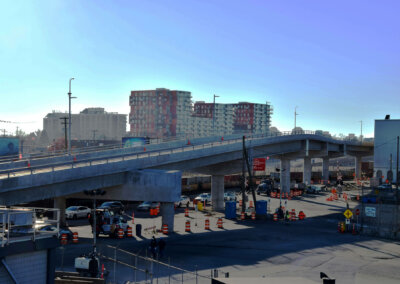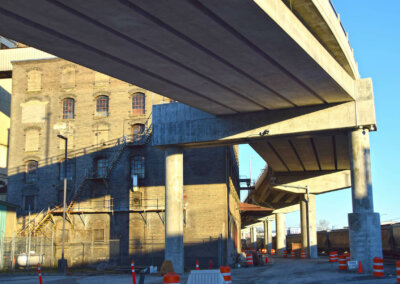About the Project
The Project is a 480m-long, 13-span slab-on-girder bridge designed to reduce road congestion and improve the movement of goods primarily to and from the Centerm Terminal. The Project improves the south shore road and rail network by eliminating at-grade crossings. The overpass’ 9.5m wide deck carries one westbound and one eastbound lane dedicated to terminal traffic. An underlying 5m wide single-lane, two-way service road also had to be constructed underneath the overpass to allow access to local businesses as well as oversized deliveries to the terminal. The overpass was designed to accommodate adjacent terminals, businesses and railways, all while remaining operational during construction. Marine vessel, truck and rail traffic, as well as all facilities’ tenants, deliveries and visitors were provided unrestricted access to and from the terminals during construction.
The overpass is located in front of the heritage Rogers Sugar building along Centennial Road. Rail tracks run directly beside and cross the structure, confining its envelope and making impact loading a design consideration. Utilities including Metro Vancouver storm water and sanitary sewers, Vancouver Fraser Port Authority and City of Vancouver infrastructure, and BC Hydro, Telus, Fortis and third party fibre-optic services all further constrained the location and geometry of the overpass. Geotechnical considerations included the existence of a 5m thick liquefiable soil composed of compressible soil layers such loose sand, trace silt, and wood waste, and the requirement to impose no additional load or settlement on existing underground infrastructure. Hatch’s design team spent extensive collaborative effort on constructability, spatial requirements, and design interfaces to successfully achieve design consent, while developing a host of bespoke solutions to overcome these challenges.
Approach
Hatch aimed for a collaborative approach to the design in order to achieve a cost-effective solution for all stakeholders with minimal operational impact through construction. In the pre-construction stage, value-engineering was performed for the best value between the reference design’s steel girder concepts versus the conventional prestress concrete girder bridge configuration eventually adopted. Single column piers were added for the shallower concrete girders for the vertical clearance needed to avoid rail track relocation, thus avoiding complex transportation logistics and operational impacts that would result in increased costs. Other design considerations included bridge structure, road, and underground civil design, electrical, rail, geotechnical, environmental, and architectural inputs all within a context of constructability for achieving multi-party stakeholder buy-in. Weekly design review meetings with construction specialists and other subject matter experts were held throughout design development. An extensive utilities identification program was developed with the contractor and in conjunction with review of record drawings and aerial photos, a detailed 3D model was created to coordinate new foundation piling, and construction was completed with no field conflicts encountered. In the construction phase, site crews worked closely with the design office for timely responses when issues needed to be resolved when unexpected field conditions were encountered.
Results
The Project met all stakeholder, operational and safety requirements by using conventional bridge structural components in combination with complex engineering detailing to overcome site constraints. The contractor’s tried and tested means and methods were able to be utilized, while the completed structure accommodated complex interfaces and satisfied the project intent of improving the transportation network without undue disruption to ongoing container terminal operations.
Service(s) Provided
-Pre-construction services
-Roadway and geotechnical engineering
-Technical advice
-Bridge and foundations engineering
-Rail engineering
-Integration of construction, operations, maintenance, and rehabilitation considerations within the design
Project Team (Consultants)
EXP
Project Team (Contractors)
Centennial Expansion Partners
Go back to projects in
View other projects from
Stay in touch with us
Subscribe to our mailing list!
Organization
Connect






